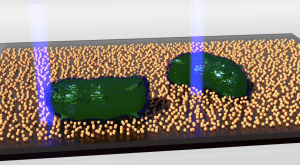After many months of preparation, the Dimensional Energy team finally gets a chance to test the photothermochemical CO2 conversion reactors as part of the CarbonXprize competition.
Good Luck!

After many months of preparation, the Dimensional Energy team finally gets a chance to test the photothermochemical CO2 conversion reactors as part of the CarbonXprize competition.
Good Luck!

Congratulations to Jessica and the rest of the team on publishing the 4D-STEM paper in Nano Letters.

The directed assembly of nanoscale building blocks into complex superstructures is of widespread scientific and technological interest. Scientists and engineers have been intrigued by the prospects of tailoring self-assembly processes to create materials whose properties and function can be tuned through the interaction between constituent particles. In particular, recent reports of superlattice structure transformations leading to epitaxially connected nanocrystal superlattices with long-range atomic coherence have generated significant interest as a platform for novel, quasi 2D ‘designer materials’. Although experimental protocols for the formation of high quality superlattices in which constituent nanocrystals are registered to within a single atomic bond length have been established, significant gaps persist in our fundamental understanding of several aspects of the underlying mechanism by which these structures form.

In this article, we apply advanced electron diffraction to investigate the superlattice transformation of lead chalcogenide (PbX, X=S, Se) nanocrystals leading up to 2D oriented attachment. We present unprecedented detail into the exact position and 3D crystallographic alignment of each polyhedral NC in the assembly derived from nanobeam electron diffraction pattern maps acquired with an electron microscope pixel array detector (EMPAD). This analysis reveals that the nanocrystals are strongly coupled along the <11n>AL direction and undergo translation with nearly constant in-plane atomic lattice orientation throughout the transformation. The rich experimental results presented here provide new mechanistic insights into the self-assembly and oriented attachment.
Congratulations to Jiyoon Kim for winning the prestigious NSF Graduate Research Fellowship!!!
Kevin successfully defended his PhD Thesis! Congrats Kevin for an outstanding job. Thanks for the bold and curiosity-driven approach to research which introduced our group to the myriad prospects of pulsed electrochemistry as a novel approach to control product selectivity





Congratulations to Jiyoon Kim for winning SRC Undergraduate Research Program (URP) award with funding from IBM.
Congratulations to Jen-Yu Huang and all co-authors on the paper “Three-Dimensional Printing of Hierarchical Porous Architectures” which will be published in Chemistry of Materials; https://pubs.acs.org/doi/abs/10.1021/acs.chemmater.9b02761

Porous materials are notoriously difficult to process, so synthetic materials are mostly in the form of powder but generally lack mesoscale structure much less processability into complex device architectures. Natural systems, on the other hand, a replete with complex hierarchical and multifunctional structures. Inspired by the beautifully complex hierarchical structures found in nature, we sought to create analogous programmable materials from inorganic building blocks. The work described in the enclosed manuscript illustrates the rich opportunity space that opened up at the intersection from recent concurrent advances in (digital) additive manufacturing and nanostructured material building blocks. We show, for the first time, that three-dimensional hierarchical materials can be printed into porous structured based on oxozirconium methacrylate cluster building blocks. This work demarks a significant step forward in creating hierarchical porous structures with control over complex macroscopic structure as well as controlled pore size distribution. The advances towards programmable porous materials reported in this manuscript have important implications for a broad range of emerging technologies spanning microfluidic bioseparation and programmable multiphase flow through porous structures.
Congratulations to Jen-Yu and all co-authors!
The U.S. Department of Energy has awarded an interdisciplinary team of Cornell researchers $2 million to study the combination of inorganic semiconductor nanoparticles and bacterial cells for more efficient bioenergy conversion.
See full story here

